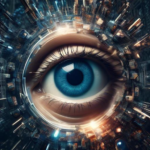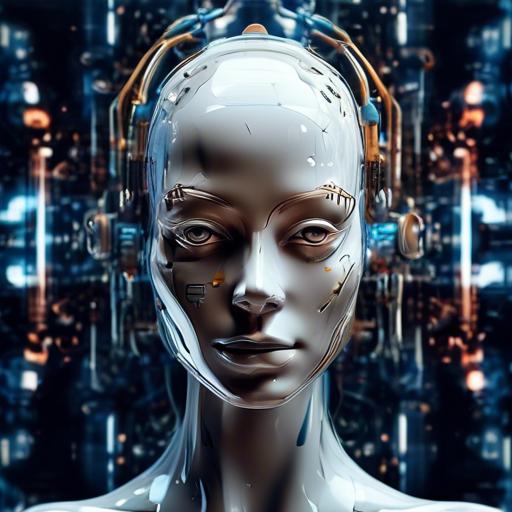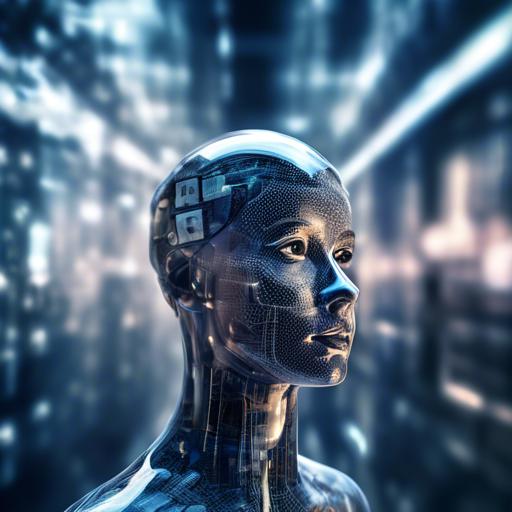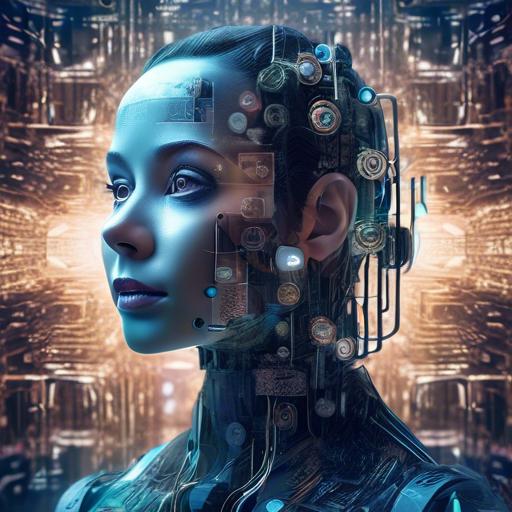In a world where the brushstrokes of a painter’s imagination once reigned supreme, a new muse has emerged from the realms of silicon and code. Today, the age-old dance between creativity and technology takes on new rhythm as we delve into the ethical debate over AI-generated art. This dialogue, brimming with passion and contemplation, bridges the gap between human ingenuity and machine potential. Here, in this unfolding narrative, we celebrate the marvel of AI’s artistic pursuits while conscientiously navigating the moral landscapes it reshapes. Join us as we explore this vibrant and thought-provoking frontier—where the past, present, and future of creativity profoundly converge.
Table of Contents
- Unveiling the Layers: Understanding AI in Artistic Creation
- The Soul of the Machine: Can AI Truly Create Art?
- Human vs. Algorithm: The Battle for Creative Authenticity
- Blurred Lines: Intellectual Property and AI-Generated Art
- The Artists Journey: How AI Impacts Creative Careers
- Fostering Collaboration: Harmonizing Human and AI Artistic Endeavors
- Ethics in the Digital Studio: Guidelines for Responsible AI Art
- In Summary
Unveiling the Layers: Understanding AI in Artistic Creation
As artificial intelligence evolves, its role in artistic creation becomes an alluring yet contentious topic. Critics often argue that AI-generated art lacks the emotional depth and intentionality of human-made works, yet supporters see it as a new frontier for creativity. Understanding the layers of AI in artistic creation involves delving into these contrasting viewpoints and examining the implications for artists and art enthusiasts alike.
AI algorithms can generate art through several sophisticated techniques, such as **Generative Adversarial Networks (GANs)** and **Deep Learning Models**. These technologies analyze vast datasets, learning patterns and styles to produce intriguing, often mesmerizing works of digital art. While some see this as a groundbreaking tool for artists, enabling them to push the boundaries of their imagination, others view it with skepticism, concerned about the potential loss of the artist’s personal touch.
Consider the ethical considerations:
- **Authenticity**: Is an artwork created by AI truly original, or merely a derivative product of existing data?
- **Intellectual Property**: Who owns the rights to an AI-generated piece – the creator of the algorithm, or the artist who used it?
- **Labor**: Could an increase in AI-generated art undermine the livelihood of traditional artists?
These questions often arise during debates about the merit and impact of AI-generated art.
| Pros | Cons |
|---|---|
| Expands creative possibilities | Questions about originality |
| Tool for creativity | Potential job displacement |
| Blends technology with art | Ownership complexities |
The integration of AI in art doesn’t necessarily have to be a zero-sum game. By fostering an appreciation for both traditional and AI-driven methods, we can celebrate the enhanced diversity and multiplicity of creativity. After all, the dialogue between man and machine could cultivate a richer, more dynamic artistic landscape where innovation flourishes alongside introspection.
The Soul of the Machine: Can AI Truly Create Art?
At the heart of the debate over AI-generated art lies the essence of creativity itself. Can a machine, governed by algorithms and code, truly produce works that resonate with the depth and emotion typically attributed to human artists? AI enthusiasts argue that advanced algorithms, particularly those involving deep learning, can mimic the complexities of human creativity, producing pieces that evoke emotions, inspire wonder, and challenge our expectations.
However, skeptics argue that AI lacks the intrinsic qualities that define human artistry. While AI can analyze patterns, styles, and techniques, it operates without the cornerstone of human experience—consciousness. These critics point out that art is not solely about the final product but also about the artist’s journey, their inspirations, and the deeply personal process of creation. Without the ability to feel, reflect, and comprehend on a human level, can AI truly grasp the nuance required to create profoundly moving art?
- Imitation vs. Innovation: Can AI only replicate pre-existing styles, or can it genuinely innovate and develop new artistic movements?
- Intentionality: Human artists imbue their work with intention and purpose. Can a machine inherently understand and embed such profound meaning?
- Emotional Depth: Art is often a reflection of the artist’s emotional landscape. Is it possible for AI to convey genuine emotion, or is it merely simulating feelings?
| Aspect | Human Artist | AI Artist |
|---|---|---|
| Creativity | Organic and Innovative | Pattern-Based and Derivative |
| Emotion | Deep and Nuanced | Simulated and Surface-Level |
| Intentionality | Purpose-Driven | Algorithm-Driven |
Despite the limitations pointed out by critics, it’s essential to recognize the unique contributions AI can make to the art world. AI systems can analyze vast datasets, identify hidden patterns, and even create hybrid styles by blending elements from different genres in ways that might not occur to human artists. AI-generated art challenges our perceptions and pushes the boundaries of what art can be, opening up new avenues for collaboration between humans and machines.
Ultimately, the question is not whether AI can replace human artists but how it can augment and expand artistic horizons. By integrating AI into the creative process, we can harness its capabilities to explore uncharted territories in art, pushing the boundaries of human imagination further than ever before.
Human vs. Algorithm: The Battle for Creative Authenticity
The rise of AI-generated art has sparked heated conversations among artists, critics, and technologists alike. **Can a machine truly replicate the nuances of human creativity?** This question sits at the heart of a larger debate about the essence of artistic authenticity. While AI boasts impressive technical skills, many argue that the soul of art lies in the human experience and emotional depth.
On one hand, AI can produce art that challenges our perceptions and pushes creative boundaries. These algorithms are trained on countless works of human art, enabling them to blend styles and generate pieces that often surprise even their creators. Enthusiasts highlight some key advantages of AI in the artistic realm:
- Speed and Efficiency: AI algorithms can create intricate pieces in a fraction of the time it would take a human artist.
- Innovative Combinations: AI can synthesize diverse styles and techniques, leading to unexpected and groundbreaking results.
- Accessibility: AI-generated art democratizes creativity, allowing individuals without traditional artistic skills to craft visually compelling works.
However, many purists maintain that **true art** stems from human emotions, experiences, and flaws—elements that machines inherently lack. The vulnerability and imperfection embodied by human creations are often seen as irreplaceable assets of artistic authenticity. This belief raises important questions:
- Can AI Appreciate the Context?: Unlike humans, machines are devoid of personal experiences and cultural contexts that enrich art.
- Originality Concerns: AI models are built on pre-existing artworks, leading to debates about whether AI-generated pieces can be truly original.
- Emotional Connection: Art often resonates on a deeply emotional level, a facet that critics argue AI cannot authentically reproduce.
| Aspect | Human Art | AI-Generated Art |
|---|---|---|
| Emotional Depth | High | Low |
| Efficiency | Moderate | High |
| Originality | Unique | Variable |
In essence, the crux of this debate lies in what we value more in art: the perfect execution of form or the imperfect expression of humanity. Each side of the argument presents compelling points, but the future of artistic authenticity will likely involve a blend of both, where **human creativity coexists with algorithmic innovation**.
Blurred Lines: Intellectual Property and AI-Generated Art
When it comes to intellectual property, AI-generated art introduces a labyrinth of questions and dilemmas. At its core, the challenge lies in determining the ownership of creations that are born from complex algorithms rather than human hands. The grey area between human creativity and machine-generated work raises various ethical issues that are difficult to navigate.
- **Authorship:** Who is the rightful creator – the AI, the programmer, or the user who provided the initial input?
- **Copyright:** Can traditional copyright laws apply to works created by AI, or do these need a complete overhaul?
- **Value:** What is the worth of AI-generated art when compared to human-made art?
In traditional art, the creator’s unique touch and emotional depth play a significant role in defining the work’s value. However, AI-generated pieces often lack this personal essence, resulting in heated discussions about their legitimacy. Adding to the complexity is the intersection of technology and creativity—where does the innovation end and the artistry begin?
Emphasizing the divergent aspects could make the topic even clearer:
| Aspect | Human Art | AI-Generated Art |
|---|---|---|
| **Creation Process** | Emotional and personal | Algorithmic and data-driven |
| **Ownership** | Clear, legally defined | Ambiguous, unresolved |
| **Value** | Subjective, based on creator | Controversial, debated |
One major concern is that AI-generated art could flood the market, potentially devaluing works created by human artists. Alternatively, some argue that AI can democratize art, enabling anyone with access to an AI tool to become an ‘artist.’ This democratization, while positive in some respects, could also dilute the significance and cultural impact that traditional art holds.
Lastly, the industry faces a significant moral stance: Should art, a deep manifestation of human expression, be left to machines? Advocates for technological integration highlight that AI-generated art could open new realms of imagination and creativity, pushing human artists toward novel innovative techniques and perspectives. Ultimately, addressing these ethical dilemmas calls for new frameworks and perhaps even new definitions of what it means to be an ‘artist’ in the digital age.
The Artists Journey: How AI Impacts Creative Careers
In the vibrant realm of creative careers, the emergence of AI-generated art stirs up an ocean of ethical considerations. Artists weigh in on whether these advanced technologies present a friend or a foe to their craft. The journey of an artist has always been about more than just creating; it’s about imparting a part of oneself into the work. There’s a looming concern that AI, while immensely innovative, might dilute the human essence in art.
Challenges to Creative Authenticity:
- The irreplaceable value of human intuition and emotion.
- The risk of homogenizing creative outputs.
- The potential for intellectual property disputes.
While AI can churn out images, music, and literature faster than any human ever could, the product often lacks a deeply personal connection. This connection is something that many patrons of the arts have come to cherish. **Does speed and efficiency outweigh the sentimental and unique value of human-made art?** This question pervades galleries and studios worldwide.
| Pros | Cons |
|---|---|
| Increased production speed | Potential loss of authenticity |
| Cost-effective solutions | Reduction in human touch |
| New creative possibilities | Intellectual property issues |
Nevertheless, the discourse isn’t entirely against AI. Artists and technologists alike see a symbiotic relationship where AI serves as an assistant rather than a replacement. Harnessed responsibly, AI has the potential to help artists push boundaries, explore new mediums, and execute radical ideas that might be humanly impossible.
Ultimately, the ethical debate over AI-generated art calls for a balance—one where technology supports creativity without overshadowing the irreplaceable human spirit. There lies an opportunity for artists to redefine their journey, leveraging AI as a tool to enhance, rather than substitute, their extraordinary creative capabilities.
Fostering Collaboration: Harmonizing Human and AI Artistic Endeavors
Human and AI collaboration in art represents a fascinating convergence, sparking creativity and innovation that transcend traditional boundaries. By fostering a partnership between human intuition and AI’s computational prowess, artists can explore uncharted territories, yielding unique outcomes that neither could achieve alone. This synergy opens doors to novel expressions, blending human emotional depth with AI’s capability to analyze vast datasets for inspiration.
- Enhanced Creativity: AI can analyze art history and styles, providing artists with fresh perspectives and ideas, fostering originality.
- Simplifying Complex Tasks: With AI handling tedious tasks, artists can focus more on the creative process, exploring complex ideas without being bogged down by technicalities.
- Access to Wider Audiences: AI algorithms can help tailor and distribute artworks to a global audience, maximizing reach and impact.
Artists now have the tools to push boundaries further than ever, using AI to not only assist but to inspire. For instance, AI can generate an artwork’s first draft based on an artist’s input, which the artist can then refine and infuse with personal touches, merging the robotic with the human. This collaborative dance between man and machine can yield artwork that is both technically impressive and deeply expressive.
The ethical concerns surrounding AI-generated art often revolve around issues of authorship and originality. However, when viewed from a collaborative perspective, AI can be seen not as a rival but as a co-creator. The role of the artist evolves from being a solitary creator to a part of a larger creative team, where their unique human qualities – intuition, emotion, and unpredictability – complement the AI’s analytical strengths.
To illustrate this harmonious relationship, consider the following table showcasing different collaboration roles and their benefits:
| Role | Human Contribution | AI Contribution |
|---|---|---|
| Idea Generation | Conceptualization | Data Analysis |
| Artwork Creation | Emotion and Nuance | Pattern Recognition |
| Final Refinement | Personal Touch | Technical Adjustment |
By embracing this collaborative approach, the art community can leverage the best of both worlds. This synthesis not only enhances the creative process but also prompts a continuous evolution of artistry, challenging and expanding our understanding of what art can be.
Ethics in the Digital Studio: Guidelines for Responsible AI Art
As we delve deeper into the realm of artificial intelligence, particularly in the creation of art, it’s crucial to establish **ethical guidelines** to navigate this new territory responsibly. The digital studio is no longer just a space for human creativity; it now includes algorithms that generate art, which raises several ethical questions.
One key area to consider is **artist attribution**. When AI creates a piece, who holds the rights? Is it the developer of the AI, the individual who trained it, or is it a collaborative effort between human and machine? These questions need clear answers to ensure fair recognition and compensation.
Another essential guideline is maintaining **transparency**. Audiences have the right to know whether the art they’re engaging with was created by a human or an AI. This transparency helps maintain trust and allows consumers to make informed choices about the art they support.
Further, ethical AI art creation must consider **cultural sensitivity**. AI systems trained on large datasets may inadvertently replicate or amplify biases present in those datasets. To combat this, art generated by AI should undergo rigorous review to ensure it respects and represents diverse cultures accurately and sensitively.
- Attribution clarity
- Transparency and disclosure
- Cultural and ethical considerations
the **environmental impact** of creating AI-generated art should not be overlooked. Training complex models often requires substantial computational power, which can have significant environmental costs. Digital studios must be mindful of their carbon footprint and strive to use sustainable practices wherever possible.
| Ethical Aspect | Description |
|---|---|
| Attribution | Clear ownership and recognition of AI-generated works. |
| Transparency | Informing audiences about the use of AI in art creation. |
| Cultural Sensitivity | Ensuring diverse and accurate representation in generated art. |
| Environmental Impact | Minimizing the carbon footprint of AI art creation. |
In Summary
the ethical debate over AI-generated art is a complex and thought-provoking issue that challenges our perceptions of creativity and authorship. As we continue to explore the capabilities of artificial intelligence in the realm of art, it is important that we approach the topic with open minds and thoughtful consideration for the implications of our actions. By engaging in respectful dialogue and ethical decision-making, we have the opportunity to shape a future where AI and human creativity can coexist harmoniously. Let us embrace the potential of AI-generated art while also upholding the values of respect, originality, and integrity in the artistic community. Together, we can navigate this exciting new frontier with grace and wisdom. Thank you for joining us on this journey.
































